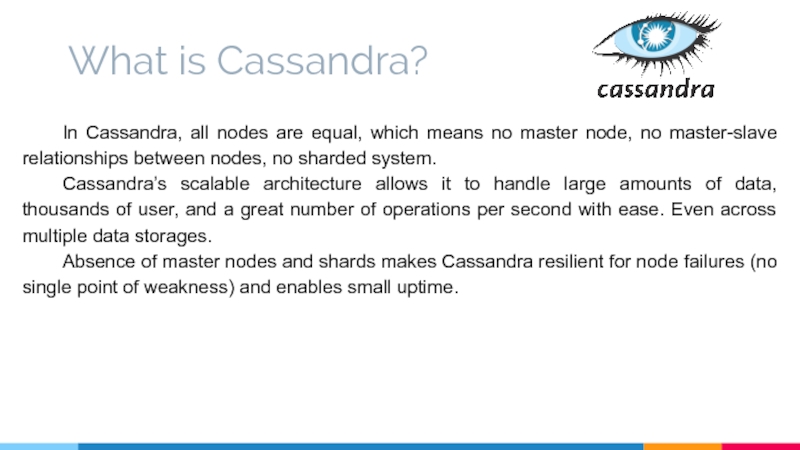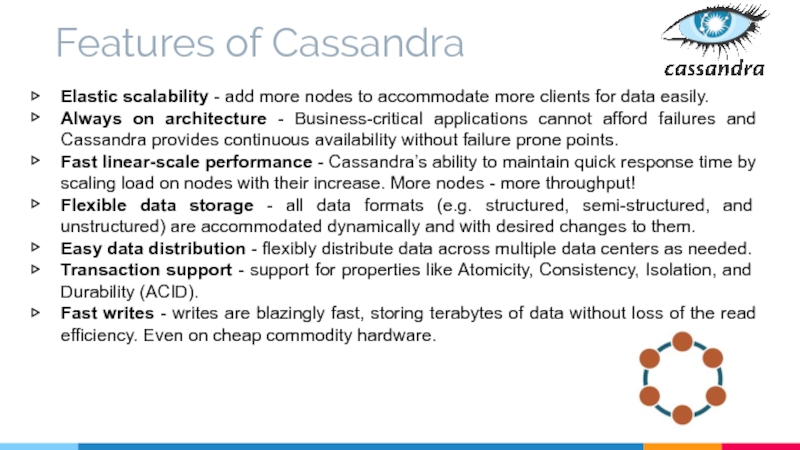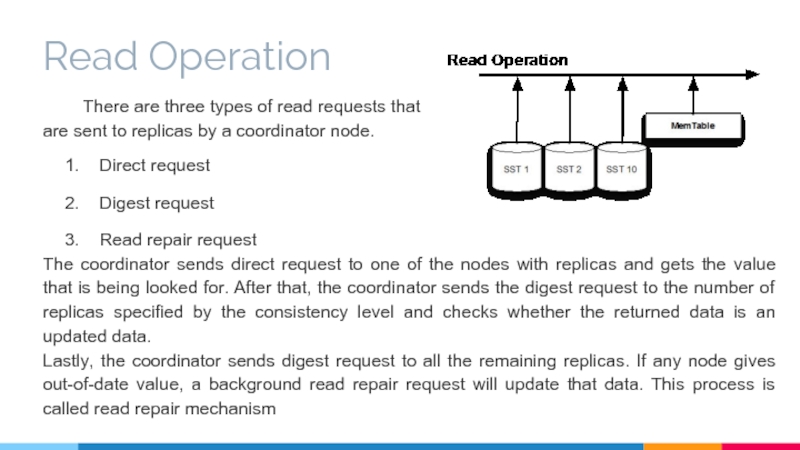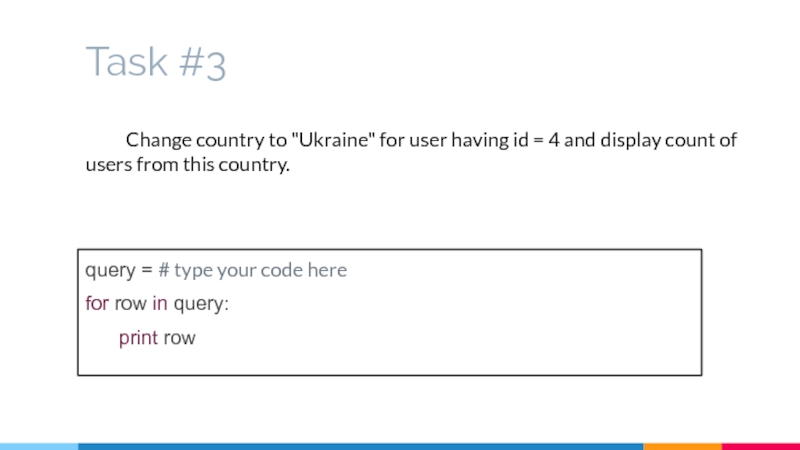- Главная
- Разное
- Дизайн
- Бизнес и предпринимательство
- Аналитика
- Образование
- Развлечения
- Красота и здоровье
- Финансы
- Государство
- Путешествия
- Спорт
- Недвижимость
- Армия
- Графика
- Культурология
- Еда и кулинария
- Лингвистика
- Английский язык
- Астрономия
- Алгебра
- Биология
- География
- Детские презентации
- Информатика
- История
- Литература
- Маркетинг
- Математика
- Медицина
- Менеджмент
- Музыка
- МХК
- Немецкий язык
- ОБЖ
- Обществознание
- Окружающий мир
- Педагогика
- Русский язык
- Технология
- Физика
- Философия
- Химия
- Шаблоны, картинки для презентаций
- Экология
- Экономика
- Юриспруденция
Install Apache Cassandra on Ubuntu. Work with Cassandra and Python презентация
Содержание
- 1. Install Apache Cassandra on Ubuntu. Work with Cassandra and Python
- 2. Week plan 1. What is Cassandra? 2.
- 3. Tutorial
- 4. What is Cassandra? Apache Cassandra is a
- 5. What is Cassandra? Cassandra’s architecture is responsible
- 6. What is Cassandra? In Cassandra, all nodes
- 7. Elastic scalability - add more nodes to
- 8. With all its shiny parts, Cassandra still
- 9. Data Replication in Cassandra In Cassandra, replicas
- 10. Components of Cassandra Node − It is
- 11. Cassandra Architecture Cluster Cassandra database is
- 12. Cassandra Query Language The Cassandra Query Language
- 13. Cassandra Operations Let’s find out how querying in Cassandra works.
- 14. Write Operation When write request comes to
- 15. Read Operation There are three types
- 16. Install Java on Ubuntu Before installing
- 17. Install Java on Ubuntu Then, install the
- 18. Install Apache Cassandra on Ubuntu
- 19. Install Apache Cassandra on Ubuntu 2. Add
- 20. Install Apache Cassandra on Ubuntu Because the
- 21. Cassandra and Python For managing Cassandra via
- 22. Create a Keyspace and Table First, you
- 23. Create a Keyspace and Table Let's create
- 24. Insert and Select Records We are going
- 25. Insert and Select Records Let's select all
- 26. Update and Delete Records Let's change country
- 27. Update and Delete Records Let's delete one
- 28. Alter Table Modify the column metadata of
- 29. Exercises
- 30. Task #1 Add a new record to
- 31. Task #2 Add new column into your
- 32. Task #3 Change country to "Ukraine" for
- 33. Thank for your attention
Слайд 2Week plan
1. What is Cassandra?
2. Install Apache Cassandra on Ubuntu
3. Work
Слайд 4What is Cassandra?
Apache Cassandra is a top level Apache project born
Cassandra offers capabilities that relational databases and other NoSQL databases simply cannot match such as: continuous availability, linear scale performance, operational simplicity and easy data distribution across multiple data centers and cloud availability.
Слайд 5What is Cassandra?
Cassandra’s architecture is responsible for its ability to scale,
Rather than using a legacy master-slave or a manual and difficult-to-maintain sharded architecture, Cassandra has a masterless “ring” design that is elegant, easy to setup, and easy to maintain.
Слайд 6What is Cassandra?
In Cassandra, all nodes are equal, which means no
Cassandra’s scalable architecture allows it to handle large amounts of data, thousands of user, and a great number of operations per second with ease. Even across multiple data storages.
Absence of master nodes and shards makes Cassandra resilient for node failures (no single point of weakness) and enables small uptime.
Слайд 7Elastic scalability - add more nodes to accommodate more clients for
Always on architecture - Business-critical applications cannot afford failures and Cassandra provides continuous availability without failure prone points.
Fast linear-scale performance - Cassandra’s ability to maintain quick response time by scaling load on nodes with their increase. More nodes - more throughput!
Flexible data storage - all data formats (e.g. structured, semi-structured, and unstructured) are accommodated dynamically and with desired changes to them.
Easy data distribution - flexibly distribute data across multiple data centers as needed.
Transaction support - support for properties like Atomicity, Consistency, Isolation, and Durability (ACID).
Fast writes - writes are blazingly fast, storing terabytes of data without loss of the read efficiency. Even on cheap commodity hardware.
Features of Cassandra
Слайд 8With all its shiny parts, Cassandra still has some let downs:
A
A lot of adjustments are made at the cluster level.
SSTable compaction, although occurs in the background, still spends a significant server resources and slows down.
There is also a disadvantage related to communication between nodes, because that protocol does not able to transfer data as stream.
Disadvantages
Слайд 9Data Replication in Cassandra
In Cassandra, replicas for a given piece of
Слайд 10Components of Cassandra
Node − It is the place where data is
Data center − It is a collection of related nodes.
Cluster − A cluster is a component that contains one or more data centers.
Commit log − The commit log is a crash-recovery mechanism in Cassandra. Every write operation is written to the commit log.
Mem-table − A mem-table is a memory-resident data structure. After commit log, the data will be written to the mem-table. Sometimes, for a single-column family, there will be multiple mem-tables.
SSTable − It is a disk file to which the data is flushed from the mem-table when its contents reach a threshold value.
Bloom filter − These are nothing but quick, nondeterministic, algorithms for testing whether an element is a member of a set. It is a special kind of cache. Bloom filters are accessed after every query.
Слайд 11Cassandra Architecture
Cluster
Cassandra database is distributed over several machines that operate
Keyspace
Keyspace is the outermost container for data in Cassandra. It is close in semantics to database.
Column Family
A column family is a container for an ordered collection of rows. Each row, in turn, is an ordered collection of columns. It has close meaning to a SQL table.
Слайд 12Cassandra Query Language
The Cassandra Query Language (CQL) is the primary language
But Cassandra is a non-relational database, and so uses different concepts to store and retrieve data. Simplistically, a Cassandra keyspace is a SQL database, and a Cassandra column family is a SQL table (CQL allows you to interchange the words “TABLE” and “COLUMNFAMILY” for convenience).
Слайд 14Write Operation
When write request comes to the node,
first of all,
In the case when remaining replicas lose data due to node downs or some other problem, Cassandra will make the row consistent by the built-in repair mechanism in Cassandra.
Слайд 15Read Operation
There are three types of read requests that
are sent
Direct request
Digest request
Read repair request
The coordinator sends direct request to one of the nodes with replicas and gets the value that is being looked for. After that, the coordinator sends the digest request to the number of replicas specified by the consistency level and checks whether the returned data is an updated data.
Lastly, the coordinator sends digest request to all the remaining replicas. If any node gives out-of-date value, a background read repair request will update that data. This process is called read repair mechanism
Слайд 16Install Java on Ubuntu
Before installing Cassandra, make sure that Java is
sudo add-apt-repository ppa:webupd8team/java
Update the package database:
sudo apt-get update
Слайд 17Install Java on Ubuntu
Then, install the Oracle JRE. Installing this particular
sudo apt-get install oracle-java8-set-default
After installing it, verify that it's now the default JRE:
java -version
Слайд 18Install Apache Cassandra on Ubuntu
We will use DataStax Community repository
1. Add the DataStax Community repository to the /etc/apt/sources.list.d/cassandra.sources.list
sudo echo "deb http://debian.datastax.com/community stable main" | sudo tee -a /etc/apt/sources.list.d/cassandra.sources.list
Слайд 19Install Apache Cassandra on Ubuntu
2. Add the DataStax repository key to
sudo curl -L http://debian.datastax.com/debian/repo_key | sudo apt-key add -
3. Install the package:
sudo apt-get update
sudo apt-get install cassandra cassandra-tools
Слайд 20Install Apache Cassandra on Ubuntu
Because the Ubuntu packages start the Cassandra
sudo service cassandra stop
Next remove the default cluster_name (Test Cluster) from the system table. All nodes must use the same cluster name.
sudo rm -rf /var/lib/cassandra/data/system/*
sudo service cassandra start
Слайд 21Cassandra and Python
For managing Cassandra via Python you have to install
Open console and run command:
pip install cassandra-driver
Слайд 22Create a Keyspace and Table
First, you need to connect to the
After that write and execute line by line the following code:
Now let's create keyspace named "my keyspace", also don't forget to add parameters.
>>> query = session.execute("CREATE KEYSPACE my_keyspace WITH replication = {'class':'SimpleStrategy', 'replication_factor':1};")
>>> from cassandra.cluster import Cluster
>>> cluster = Cluster()
>>> session = cluster.connect()
>>> session
Слайд 23Create a Keyspace and Table
Let's create a table, it will be
>>> session.execute(
... """
... CREATE TABLE users_ (
... id VARINT,
... name TEXT,
... born VARINT,
... country TEXT,
... PRIMARY KEY (id)
... );
... """
... )
Слайд 24Insert and Select Records
We are going to add data to our
>>> dict = {'name':'User_3','born': 1987,'country':'Czech Republic',}
>>> session.execute("""INSERT INTO users_ (id, name, born, country) VALUES (3, %(name)s, %(born)s, %(country)s)""", dict)
>>> session.execute("USE users_")
>>> session.execute("INSERT INTO users_(id, name, born, country) VALUES (1, 'User_1', 1991, 'Ukraine')")
>>> name = "User_2"
>>> born = 1990
>>> country = "Poland"
>>> session.execute("INSERT INTO users_(id, name, born, country) VALUES (2, %s, %s, %s)", (name, born, country))
Слайд 25Insert and Select Records
Let's select all the records to make sure
Now we are going to try to filter the entries, for example let's display data for a user named "User_1".
>>> query = session.execute("SELECT * FROM users_")
>>> for row in query:
... print row
>>> query = session.execute("SELECT * FROM users_ WHERE name='User_1' ALLOW FILTERING;")
>>> for row in query:
… print row
Слайд 26Update and Delete Records
Let's change country for record with id =
>>> session.execute("UPDATE users_ SET country='Canada' WHERE id=3")
>>> query = session.execute("SELECT * FROM users_")
>>> for row in query:
… print row
Слайд 27Update and Delete Records
Let's delete one of the records, such as
>>> session.execute("DELETE FROM users_ WHERE id=2")
>>>query = session.execute("SELECT * FROM users_")
>>> for row in query:
… print row
Слайд 28Alter Table
Modify the column metadata of a table.
Adding a column
To add
Dropping a column
To remove (drop) a column from the table, use ALTER TABLE and the DROP instruction.
>>> session.execute("ALTER TABLE users_ ADD lastname text")
>>> session.execute("ALTER TABLE users_ DROP lastname ")
Слайд 30Task #1
Add a new record to the users_ table with the
To check the correctness of this and the following task you is proposed to solve few tests in the web page of the current course related with the respective task.
# type your code here
query = session.execute("SELECT * FROM users_")
for row in query:
print row
Слайд 31Task #2
Add new column into your table, let it be called
# type your code here
for row in session.execute("SELECT * FROM users_"):
print row
Слайд 32Task #3
Change country to "Ukraine" for user having id = 4
query = # type your code here
for row in query:
print row






















 >> session.execute(... """..." alt="">
>> session.execute(... """..." alt="">














